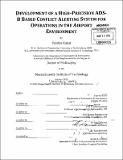| dc.contributor.advisor | R. John Hansman. | en_US |
| dc.contributor.author | Kunzi, Fabrice | en_US |
| dc.contributor.other | Massachusetts Institute of Technology. Department of Aeronautics and Astronautics. | en_US |
| dc.date.accessioned | 2014-05-23T19:35:58Z | |
| dc.date.available | 2014-05-23T19:35:58Z | |
| dc.date.copyright | 2013 | en_US |
| dc.date.issued | 2014 | en_US |
| dc.identifier.uri | http://hdl.handle.net/1721.1/87479 | |
| dc.description | Thesis: Ph. D., Massachusetts Institute of Technology, Department of Aeronautics and Astronautics, February 2014. | en_US |
| dc.description | Cataloged from PDF version of thesis. "October 2013." | en_US |
| dc.description | Includes bibliographical references (pages 217-225). | en_US |
| dc.description.abstract | The introduction of Automatic Dependent Surveillance - Broadcast (ADS-B) as the future source of aircraft surveillance worldwide provides an opportunity to introduce high-precision airborne conflict alerting systems for operations in high-density traffic environments. Current alerting systems have been very successful at preventing mid-air collisions in the en-route environment but have limited benefit in high-density environments such as near airports where most mid-air collisions occur (59%). Furthermore, introducing an ADS-B-enabled conflict alerting system generates an incentive for General Aviation users to voluntarily equip with ADS-B avionics. The work presented in this thesis describes the process followed to develop an ADS-B-enabled, high-precision conflict alerting system. This system will be the basis for the international certification standard guiding future implementations of such systems. The work was conducted as part of the larger development effort of the Traffic Situation Awareness with Alerting (TSAA) ADS-B application. As a first step, a set of 18 high-level system requirements was identified based on a stakeholder analysis and review of mid-air collisions that occurred over the last 10 years. An alerting algorithm was then developed based on the system requirements that builds on the precedent set by current alerting systems but takes advantage of the improved state information available via ADS-B. The distinguishing factors of the algorithm are its use of a constant turn rate trajectory prediction and its consideration of the current and predicted encounter geometry in the alerting decision. Next, a method to tune the performance of the algorithm was developed and demonstrated. The method applies the Latin hypercube sampling approach to generate a large set of different algorithm implementations, which were then evaluated by simulating the alerting performance on a representative data set of airborne encounters. Lastly, the method introduced an approach to evaluate and "visualize" the five-dimensional performance space defined by the five performance metrics of interest for alerting systems. Using the tuned algorithm, a flight test program was conducted. The performance of the algorithm during the flight test was analyzed in-depth and compared to the expected performance. Given the insights from the tuning and the flight test, additional alerting logic was introduced to the basic algorithm, which significantly improved overall alerting performance. The performance of the final system implementation is significantly better or equal to that of the current industry standard for all five performance metrics. The nuisance and overall alert rate were each reduced by a factor of more than 4 and the average time of alert before the closest point of approach increased by 6 seconds as compared to current systems. Enabled by this performance improvement, TSAA introduces reliable collision alerting to the Airport Environment where most of today's mid-air collisions occur and where today's alerting systems are of limited benefit due to high rates of nuisance alerts. | en_US |
| dc.description.statementofresponsibility | by Fabrice Kunzi. | en_US |
| dc.format.extent | 245, 18 unnumbered pages | en_US |
| dc.language.iso | eng | en_US |
| dc.publisher | Massachusetts Institute of Technology | en_US |
| dc.rights | M.I.T. theses are protected by copyright. They may be viewed from this source for any purpose, but reproduction or distribution in any format is prohibited without written permission. See provided URL for inquiries about permission. | en_US |
| dc.rights.uri | http://dspace.mit.edu/handle/1721.1/7582 | en_US |
| dc.subject | Aeronautics and Astronautics. | en_US |
| dc.title | Development of a high-precision ADS-B based conflict alerting system for operations in the airport environment | en_US |
| dc.title.alternative | Development of a high-precision Automatic Dependent Surveillance - Broadcast based conflict alerting system for operations in the airport environment | en_US |
| dc.type | Thesis | en_US |
| dc.description.degree | Ph. D. | en_US |
| dc.contributor.department | Massachusetts Institute of Technology. Department of Aeronautics and Astronautics | |
| dc.identifier.oclc | 879663270 | en_US |
